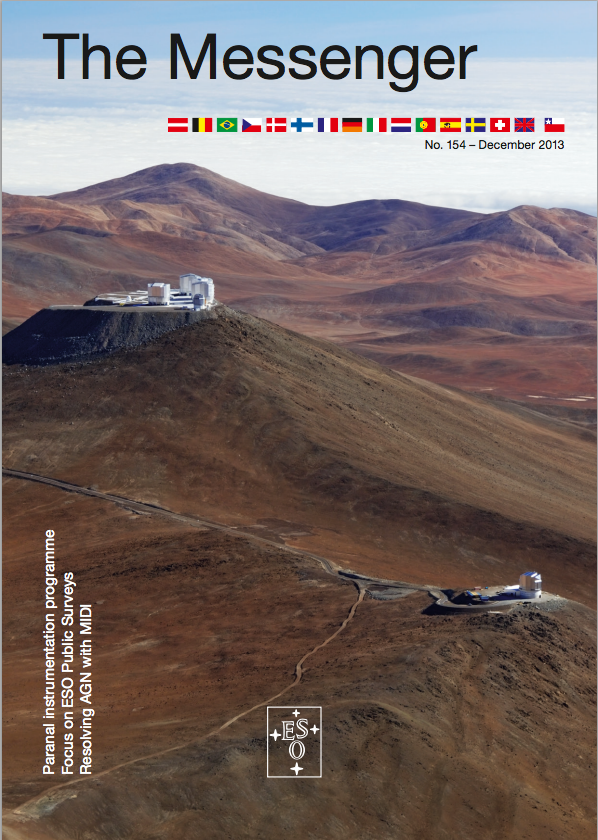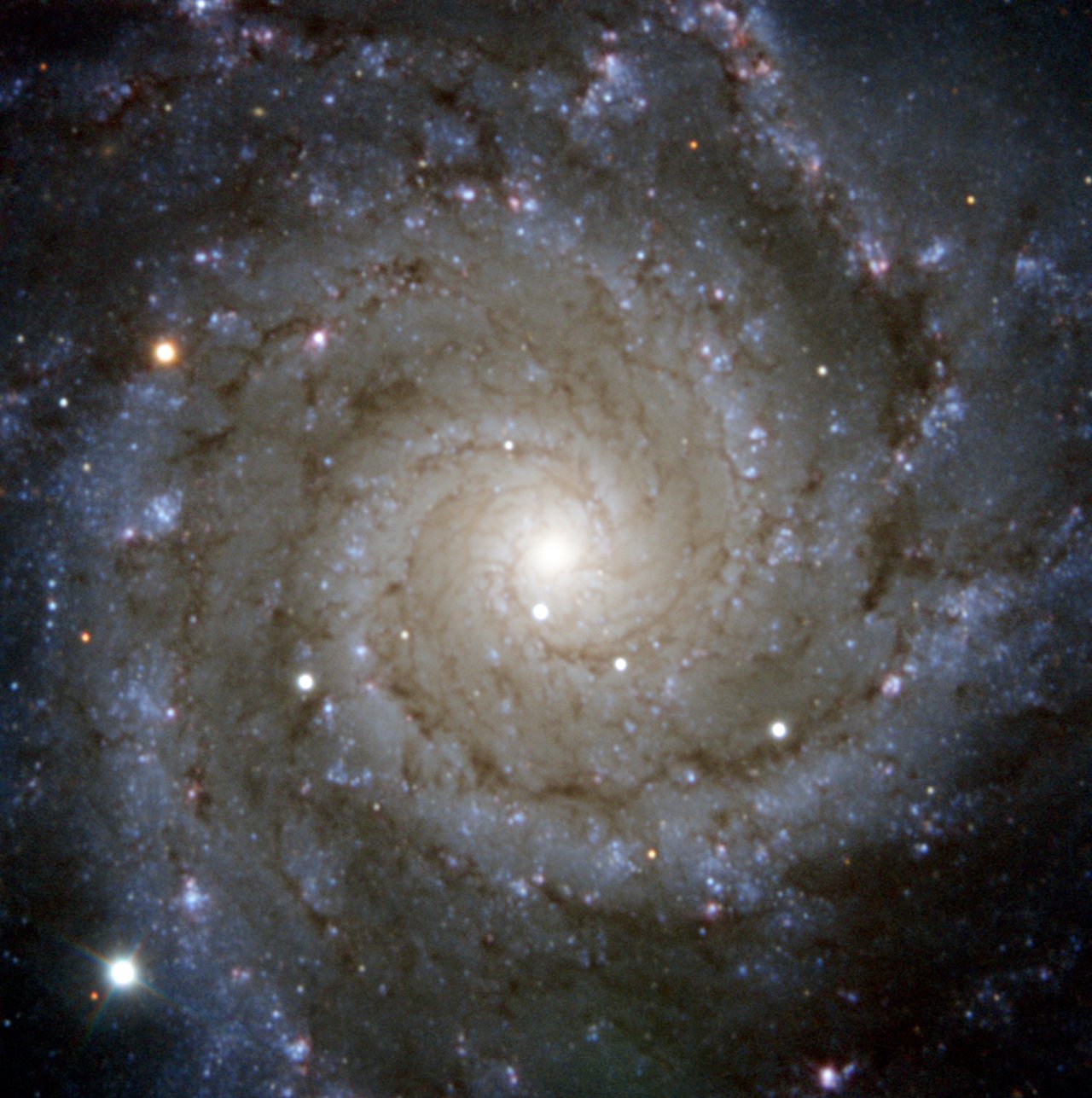click on a news item to read more
The Release of PESSTO SSDR4
PESSTO SSDR4 has now been released via the ESO Science Portal and includes all EFOSC and SOFI spectra and SOFI images from the full 7 years of PESSTO and ePESSTO operations; April 2012 to April 2019. Also included is an updated version of the transient catalogue covering the same time period. In total the entire data-set comes to 45GB of reduced data-products.
The release comprises of 2323 unique transient sources including supernovae, galactic-novae, tidal disruption events and observations of the first kilonova ever discovered (AT2017gfo). Alongside observations used for spectral classification of many ...
100 science papers from PESSTO and its successor surveys
PESSTO and its successor surveys have reached 100 published, refereed science papers. The latest 3 papers to bring us to 100 have just been published, on two long gamma ray burst and a plausible candidate for the first neutron star - white dwarf merger.
Owen McBrien, a PhD student at Queen’s University Belfast lead an ApJ Letter on the unusually fast declining transient SN2018kzr. It is the fastest declining transient that either PESSTO or ePESSTO has followed other than the kilonova AT2017gfo. It was also quite luminous, meaning a combinatio ...
The Start of ePESSTO+
PESSTO has now reached its second extension and another chapter with a new management (PI Cosimo Inserra) has started.
The “advanced” extended Public ESO Spectroscopic Survey of Transient Objects (ePESSTO+) was approved with an initial 1.5 year Large Programme by the ESO OPC starting in April 2019. From Period 103 we were approved to continue our spectroscopic survey as ePESSTO+. The operational mode of around 10N per month over 9 - 10 lunations during the year will continue and we will continue to provide immediate public classifications and classification spectra through the new WiSeREP.
The scie ...
A kilonova as the electromagnetic counterpart to a gravitational wave source - ePESSTO Letter to Nature and data release
Image obtained by ESO’s Gamma-ray Burst Optical/Near-infrared Detector (GROND) attached to the MPG/ESO 2.2-metre telescope at La Silla Observatory. Credit: ESO/S. Smartt & T.-W. Chen.
The first electromagnetic counterpart to a gravitational wave source has been discovered and the ePESSTO team led one of the most extensive studies on optical and near-infrared evolution of the transient. LIGO-Virgo detected ...
The start of ePESSTO - a new 2 year Large Programme at the NTT
A new phase in the evolution of PESSTO has started. The “extended” Public ESO Spectroscopic Survey of Transient objects was approved as a 2 year Large Programme by the ESO OPC starting in April 2017. From Period 99 we were approved to continue our spectroscopic survey as ePESSTO. The operational mode of around 10N per month over 9 - 10 lunations during the year will continue and we will continue to provide immediate public classifications and classification spectra through WiSeREP.
The scientific focus of ePESSTO has been adj ...
PESSTO SSDR3 Released
PESSTO SSDR3 Data Release has been published and is now available for download from the here.
In four years of operations, PESSTO has taken spectra of 1168 distinct objects. From this list, 161 supernovae (10 of which are super-luminous supernovae), 2 supernova imposters, 3 Tidal Disruption Events, 1 unclassified objects and 1 AGN were picked as interesting science targets and these were scheduled for follow-up time series EFOSC2 optical spectroscopy, with the brightest also having SOFI spectra taken.
In total SSDR3 contains 21.29GB of data. In total there are 2851 EFOSC2 spectra released. These include 1753 EFOSC spe ...
PESSTO Special data release - nebular spectra of superluminous supernovae
The paper by Anders Jerkstrand et al. ESO (VLT + FORS2, VLT + Xshooter, NTT + EFOSC2) for three superluminous supernovae at late times. LSQ14an and SN2015bn/PS15ae were PESSTO follow-up targets.
Figure 7 of Jerkstrand et al. (2017):

There are various corrections applied to the spectra to scale them to photometry and to subtract off the host galaxy contributions. The paper includes photometry corrected and host galaxy subtracted spectra of SN2007bi using new ...
PESSTO’s view on the superluminous event ASASSN-15lh

Spectral sequence of ASASSN-15lh over 260 days. From Leloudas et al. 2016, Nature Astronomy : PUBLISHED: 12 DECEMBER 2016 | VOLUME: 1 | ARTICLE NUMBER: 0002
Giorgos Leloudas led the PESSTO campaign to understand the nature of the extraordinary ASASSN-15lh with a paper in Nature Astronomy’s first edition. The paper was major press release my ESO.
This object was discovered last year by thought to be the most luminous supernova ever discovered. The PESSTO campaign, combin ...
PESSTO the world’s leading classification engine
PESSTO’s science goals have been to study the extremes of the explosive populations being found in large numbers by the most efficient surveys that have ever run. An important part of running the survey is taking a spectrum as quickly as possible after a transient is found and also to release the data, classification, redshift and any important or unusual characteristics. We do this on a daily basis, and nearly always within 12hrs of the end of the Chilean night.
As of January 1, 2016 the Weizmann Institute of Science, this is a continuation of the IAU naming ...
Latest update as PESSTO starts its fifth year
A full list of publications are here.
In partnership with Pan-STARRS, PESSTO is classifying transients from the (announced in Seppo Mattila’s recent Astronomer’s telegram)
...PESSTO SSDR2 Released
PESSTO SSDR2 has been published and is now available for download from the ESO Catalogue Facility.
In its second year of operations, PESSTO has taken spectra of 395 distinct objects, bringing the overall total to 681 objects. During this second year 42 supernovae and 1 AGN were chosen as interesting science targets and scheduled for follow-up time series EFOSC2 optical spectroscopy, with the brightest also having SOFI spectra (the 1 AGN was not followed in detail).
In total 798 EFOSC2 spectra have been released. These include 411 EFOSC2 spectra of our science targets which are chosen for detailed follow-up. The oth ...
A new method for measuring nickel masses in type Ia supernova

Mike Childress has submitted a paper analysing 94 nebular spectra of type Ia supernovae in the most extensive study to date of cobalt emission lines. Type Ia supernovae are powered by the radioactive decay of 56-Ni to 56-Co during their early phases. After about 60 days the decay of 56-Co to stable 56-Fe powers their luminosity. Mike’s paper shows that the initial mass of 56-Ni can be determined from the flux in the cobalt 5892 Angstrom line (a forbidden transition of Co III). This is po ...
A surprising new discovery for superluminous supernovae
We have made a surprising discovery of a double-parked light curve of a super-luminous supernova. The dense daily cadence of the La Silla QUEST survey produced a beautifully sampled lightcurve of LSQ14bdq, which was classified as a superluminous SN by PESSTO on 2014 March 22 at a redshift z=0.345. Matt Nicholl spotted the excess flux in the LSQ images when studying the LSQ data for early lightcurve. Matt’s paper (published in ApJ letters) proposes this “bump” is post-shock cooling after breakout of the SN shock from the stellar surface. However ...
BBC Stargazing Live and SkyMapper Discover Supernova

Our friends in the SkyMapper team, led by Richard Scalzo and Fang Yaun, have been working with the BBC on Stargazing Live to find supernovae and providing candidates to Zooniverse for viewers all round the world to look through images for real exploding stars. The team found this object SMTJ13254308-2932269 on 18th March and immediately sent the details to Heather Campbell who is observing for PESSTO on the NTT in La Silla ...
Four New PESSTO Papers
Four more PESSTO papers have been submitted or accepted in February 2015. The PESSTO legacy data set for SN2009ip continues, with Morgan Fraser’s paper presenting the photometric and spectroscopic data for SN2009ip during 2013 and 2014 observing seasons. Elisabeth Gall submitted a paper on LSQ13cuw discovered within a day of explosion by our partners in the La Silla QUEST survey. Andrea Pastorello’s substantial series of papers on type Ibn supernovae continues with papers V and VI in the series being supported with PESSTO data. PESSTO has now published (or submitted) 22 papers, with approximately another 20 in prepara ...
PESSTO’s Serendipitous Supernova Discovery
For the first time PESSTO have discovered a supernova of their own! The supernova was discovered in UBVRI EFOSC imaging taken of galaxy ESO-154-G010, the host of the previous supernova SN2013fc, on the 16th November 2014. Tuomas Kangas (University of Turku) spotted the new transient while taking images for the PESSTO campaign on SN2013fc. The supernova is identified in the composite VRI colour-image below by the red cross-hairs and has been reported Smith et al. ATel 6739 . This is an excellent opportunity to study a young, peculiar SN from before maximum light to the nebular phase and ...
OGLE-2013-SN-079: a lonely supernova consistent with a helium shell detonation
OGLE-2013-SN-079: a lonely supernova consistent with a helium shell detonation, a new PESSTO paper by Inserra et al. is now published in ApJ letters (January 2015).
We present observational data for a peculiar supernova discovered by the OGLE-IV survey and followed by the Public ESO Spectroscopic Survey for Transient Objects. The inferred redshift of z=0.07 implies an absolute magnitude in the rest-frame I-band of M_I~-17.6. This places it in the luminosity range between normal Type Ia SNe an ...
PESSTO SSDR1 Released
PESSTO SSDR1
The paper “PESSTO : survey description and products from the first data release by the Public ESO Spectroscopic Survey of Transient Objects” has been submitted to A&A and is available on the arXiv as a preprint here.
The PESSTO SSDR1 spectral data was released in January 2014 and is available from the ESO archive search and retrieve interface.
This included EFOSC2 and SOFI spectra. In September 2014, ESO released version 2, which now includes reduced and calibrated SOFI images. This release concludes SSDR1. The second full data release will come in early 201 ...
Superluminous supernovae from PESSTO
Nicholl, et al. is now published in MNRAS.
We present optical spectra and light curves for three hydrogen-poor super-luminous supernovae followed by the Public ESO Spectroscopic Survey of Transient Objects (PESSTO). Time series spectroscopy from a few days after maximum light to 100 days later shows them to be fairly typical of this class, with spectra dominated by Ca II, Mg II, Fe II and Si II, which evolve slowly over most of the post-peak photospheric phase. We determine bolometric light curves and apply simple fitting tools, based on the diffusion of energy input by ...
ESO Messenger Article

ESO have published an article on PESSTO in the full article here.
...PESSTO image selected as ESO Picture of the week
This PESSTO image of Messier 74, hosting Type II SN2013ej, has been selected as an ESO Picture of the Week. The supernova is the brightest object found in the bottom left corner of the image. See the ESO webpages for more details.

Published PESSTO papers
Many PESSTO papers have now been published and there are more in the pipeline. See our papers page for the details.
...